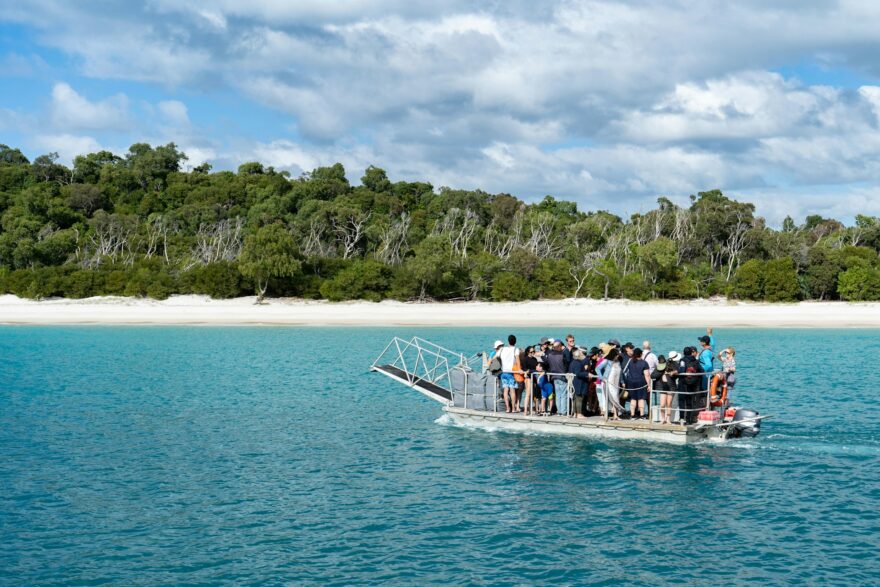The Whitsundays, a stunning archipelago of 74 islands off Queensland’s coast, is a tropical paradise known for its white sandy beaches, turquoise waters, and proximity to the Great Barrier Reef. Whether you’re dreaming of sailing, snorkeling, or relaxing on iconic Whitehaven Beach, timing your visit to the Whitsundays is key to enjoying great weather and making the most of your trip. This beginner-friendly guide explores the best times to visit the Whitsundays, breaking down the seasons, weather patterns, and activities to help you plan a memorable adventure. With practical tips and insights, you’ll be ready to experience this Australian gem at its finest.
Understanding the Whitsundays’ Climate
The Whitsundays enjoy a tropical climate with two main seasons: the dry season (April to October) and the wet season (November to March). Temperatures range from 20°C to 32°C (68°F to 90°F) year-round, making it a warm destination even in winter. However, rainfall, humidity, and marine conditions vary significantly, affecting everything from sailing to beach days.
For a quick overview of tropical destinations like the Whitsundays, magchrono com offers travel inspiration and seasonal guides to help you choose the perfect time for your trip.
The Best Time to Visit: Dry Season (April to October)
The dry season is widely considered the best time to visit the Whitsundays, offering sunny days, low humidity, and calm seas. This period, particularly from June to August, is peak season due to ideal conditions for outdoor activities like sailing, snorkeling, and hiking. Average temperatures range from 22°C to 26°C (72°F to 79°F), with minimal rainfall, making it perfect for exploring islands like Hamilton, Daydream, or Whitsunday Island.
For up-to-date travel tips on planning a dry-season trip, check site:quicknewspulse.com, which provides quick guides on destinations like the Whitsundays, including activity recommendations.
June to August: Peak Season Perfection
June to August is the sweet spot for great weather, with clear skies and gentle breezes. These months attract families, couples, and adventure seekers, as the calm waters are ideal for sailing and diving at the Great Barrier Reef. Whitehaven Beach, with its swirling silica sands, is at its most photogenic, and visibility for snorkeling is excellent.
However, peak season means higher prices and crowds, especially on Hamilton Island. Book accommodations and tours early to secure deals. spiderhere com offers budget-friendly advice for visiting popular destinations during busy periods, helping you save on your Whitsundays trip.
April, May, September, and October: Shoulder Seasons
The shoulder months—April, May, September, and October—offer a balance of good weather and fewer crowds. April and May see slightly more rain than June to August but remain warm and sunny, with temperatures around 25°C (77°F). September and October are warmer, with highs up to 28°C (82°F), and the seas are still calm for water activities.
These months are ideal for travelers seeking quieter beaches and lower prices. For ideas on planning a shoulder-season getaway, ideaspry com shares creative itineraries for destinations like the Whitsundays.
The Wet Season: November to March
The wet season brings higher humidity, frequent rain, and a risk of tropical cyclones, particularly from January to March. Temperatures climb to 30°C–32°C (86°F–90°F), and heavy showers can disrupt outdoor plans. However, the wet season has its perks: lush greenery, fewer tourists, and lower prices for accommodations and tours.
For insights into visiting tropical destinations during the wet season, site:trendflipso.com provides guides on making the most of rainy periods in places like the Whitsundays.
November and December: Early Wet Season
November and December mark the start of the wet season, with occasional showers but plenty of sunny days. These months are less risky for cyclones, and the warm weather is great for swimming. Snorkeling and diving are still enjoyable, though visibility may be slightly reduced compared to the dry season.
Travelers on a budget will find deals on flights and resorts during this time. trendflipso com highlights cost-saving tips for early wet-season travel to the Whitsundays.
January to March: Peak Wet Season
January to March is the heart of the wet season, with the highest rainfall and humidity. Tropical cyclones are a risk, particularly in February and March, and can lead to rough seas and canceled tours. However, indoor activities like spa days or visiting the Airlie Beach markets are great alternatives.
The wet season also brings vibrant marine life, including turtle-hatching season. For more on eco-friendly activities during this period, formerlylife com offers tips on sustainable travel in the Whitsundays.
Activities and Weather Considerations
The Whitsundays offer a range of activities, and the weather plays a big role in what’s available. Here’s how the seasons impact popular experiences:
- Sailing: The dry season’s calm waters are ideal for sailing tours, with multi-day trips exploring secluded cays. Wet-season sailing is possible but may face disruptions due to storms.
- Snorkeling and Diving: June to October offers the best visibility for exploring the Great Barrier Reef. November to March can still be good, but check marine forecasts.
- Beach Days: Whitehaven Beach and other shores are stunning year-round, but the dry season ensures sunny, comfortable conditions.
- Hiking: Trails on Whitsunday Island, like the Hill Inlet lookout, are best tackled in the cooler dry season to avoid wet-season mud.
For activity recommendations tailored to the Whitsundays, site:primepressblast.com provides detailed guides to help you plan your itinerary.
Marine Stingers: A Seasonal Concern
From November to May, marine stingers (box jellyfish and Irukandji) are present in the Whitsundays’ waters, posing a risk to swimmers. Beaches like Airlie Beach’s lagoon are stinger-free, and many tour operators provide stinger suits for snorkeling and diving. Always follow local advice and swim at patrolled beaches.
For safety tips on tropical beach destinations, primepressblast com offers practical advice for travelers visiting places like the Whitsundays.
Festivals and Events by Season
The Whitsundays host events year-round, adding a festive vibe to your trip. Here are some highlights:
- Airlie Beach Race Week (August): A dry-season sailing regatta that draws crowds for races and parties.
- Hamilton Island Race Week (August): Another sailing event, perfect for yacht enthusiasts.
- Whitsundays Writers Festival (September): A cultural event for book lovers, held in the shoulder season.
- Australia Day Celebrations (January): Wet-season festivities with beach events and fireworks.
For a calendar of events in the Whitsundays, vinxtra com shares updates on festivals and activities to enhance your visit.
Getting to the Whitsundays
The Whitsundays are accessible via Whitsunday Coast Airport (Proserpine) or Hamilton Island Airport. Flights from Brisbane, Sydney, or Melbourne take about 1.5 to 2 hours. From Proserpine, a 30-minute shuttle or taxi ride gets you to Airlie Beach, the mainland hub for island ferries. Hamilton Island has direct ferries to other islands and the Great Barrier Reef.
For travel logistics, site:vinxtra.com provides guides on reaching remote destinations like the Whitsundays, including flight and ferry tips.
Where to Stay
The Whitsundays offer accommodations for every budget, from hostels in Airlie Beach to luxury resorts on Hamilton Island. Airlie Beach is a great base for backpackers, with options like Nomads Airlie Beach. Hamilton Island’s Reef View Hotel suits families, while Daydream Island Resort is ideal for couples.
For solo travelers or those seeking unique stays, voxnovax com recommends boutique accommodations and budget-friendly hostels in the Whitsundays.
Budgeting for Your Trip
The Whitsundays can be pricey during peak season, with resort stays costing $200–$500 per night and sailing tours starting at $150 per day. Shoulder and wet seasons offer better deals, with hostels at $30–$50 per night and meals averaging $10–$25. To save, book tours as a group and eat at local markets.
For budgeting tips, site:voxnovax.com breaks down costs for tropical destinations, helping you plan an affordable Whitsundays trip.
Packing for the Weather
Packing for the Whitsundays depends on the season:
- Dry Season: Light clothing, swimwear, sunscreen, a hat, and comfortable shoes for hiking.
- Wet Season: Add a lightweight raincoat, quick-dry clothing, and an umbrella for sudden showers.
- Year-Round: Bring reef-safe sunscreen, insect repellent, and a reusable water bottle.
For packing advice, findefun com offers beginner-friendly checklists for tropical travel.
Sustainability and Respecting the Environment
The Whitsundays are part of the Great Barrier Reef World Heritage Area, so sustainable travel is crucial. Use reef-safe sunscreen, avoid touching corals, and stick to marked trails to protect fragile ecosystems. Many tour operators, like Ocean Rafting, follow eco-friendly practices.
For tips on sustainable travel in the Whitsundays, site:findefun.com highlights ways to minimize your environmental impact.
Why Timing Matters
Choosing the right time to visit the Whitsundays ensures you enjoy great weather and activities that suit your interests. The dry season (April to October) is perfect for sailing and snorkeling, while the wet season (November to March) offers lush scenery and budget-friendly deals. Shoulder months like May and September strike a balance, with mild weather and fewer crowds.
For more on planning your trip, site:magchrono.com and site:spiderhere.com offer curated guides to tropical destinations like the Whitsundays.
Practical Tips for First-Time Visitors
- Book Early: Secure flights, accommodations, and tours 3–6 months in advance for peak season.
- Check Weather Forecasts: Monitor marine conditions, especially in the wet season.
- Stay Connected: Buy a local SIM card in Airlie Beach for data and calls.
- Respect Locals: Follow cultural norms, like dressing modestly outside beaches.
For beginner-friendly travel advice, site:ideaspry.com and site:formerlylife.com provide tips for exploring destinations like the Whitsundays.






